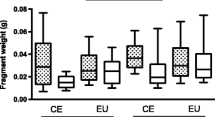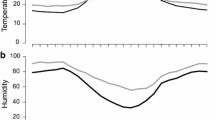Summary
The foraging activity of the leaf-cutting antsAtta sexdens andA. cephalotes was studied observing two colonies of each species in a primary forest of the Central Amazon. These two ant species utilize chemically and visually marked trunk trails, and it was show that foraging is centered on these trails. The number of new foraging sites was inversely reated to the distance from existing trails. As a consequence, the area effectively exploited by the studied colonies was only 15 to 23% of their respective foraging ranges.
Both species attacked large trees (stem diameter >20 cm) in a proportion higher to the available one and this preference seems to be related with quality of the harvested material and with the “area restricted search” strategy employed by these ants. Although these ants were able to exploit a wide range of plant species, harvest activity was concentrated on only a few. New leaves was the main item foraged byA. cephalotes whereasA. sexdens did not show a pattern of plant part preference.A. sexdens also presented a higher temporal variation in foraging rates, and this variation was partiallly related to the type of plant part harvested. It is suggested that the more generalistic behaviour presented byA. sexdens is one of the factors that contributes to its diverse habitat distribution as compared toA. cephalotes.
Resume
L'activité alimentaire des fourmis champignonnistesAtta sexdens etA. cephalotes a été étudiée par l'observation de deux colonies de chaque espèce dans une forêt dense humide primaire d'Amazonie Centrale. Ces deux espèces utilisent des pistes marquées visuellement et chimiquement. Il a été démontré que l'activité alimentaire est orientée sur ces pistes: le nombre de nouveaux sites d'alimentation est inversement lié à la distance à une piste déjà existante. En conséquence, 15 à 23 % seulement du rayon du territoire d'alimentation des colonies est effectivement utilisé.
Les deux espèces attaquent de manière préférentielle de grands arbres (diamètre du tronc à hauteur d'homme >20 cm). Cette préférence semble liée à la qualité du matériel végétal récolté et à la stratégie de recherche sur une aire restreinte employée par ces fourmis. Bien que ces fourmis aient exploité un grand nombre d'espèces végétales, l'activité alimentaire est concentrée sur un petit nombre de celles-ci. Les jeunes feuilles sont le principal élément exploité parA. cephalotes cependant queA. sexdens ne montre aucune préférence par rapport au type de matériel végétal récolté. Cette dernière espèce présente également une plus grande variation temporelle des taux d'alimentation qui est liée, en partie, au type de matériel récolté. Il est suggéré que le comportement non spécialisé présenté parA. sexdens est un des facteurs qui contribuent au fait qu'elle occupe un plus grand nombre d'habitats queA. cephalotes.
Similar content being viewed by others
References
Borgmeier T., 1959. — Revision der GattungAtta Fabricius (Hymenoptera-Formicidae).Studia Ent., 2, 321–390.
Cherrett J. M., 1968. — The foraging behaviour ofA. cephalotes L. (Hymenoptera-Formicidae). Foraging pattern and plant species attacked in tropical rain forest.J. Anim. Ecol., 37, 387–403.
Cherrett J. M., 1981. — The interaction of wild vegetation and crops in leaf-cutting ant attack. In:Pests, pathogens and vegetation, Tresh J. M., ed., Pitman Advanced Publishing, Boston, pp. 315–325.
Fowler H. G., Pereira da Silva V., Forti L. C., Saes N. B., 1986. — Population dynamics of leaf-cuting ants: a brief review. In:Fire ants and leaf-cutting ants: biology and management Lofgren C. S., Vander Meer R. K., eds., Westview Press, Boulder and London, pp. 123–145.
Fowler H. G., Robinson S. W., 1979. — Foraging byAtta sexdens (Formicidae-Attini): seasonal patterns, caste and efficiency.Ecol. Entomol., 4, 239–247.
Fowler H. G., Stiles E. W., 1980. — Conservative resource management by leaf-cutting: ants? The role of forging territores and trails and environmental patchiness.Sociobiology, 5, 25–41.
Gonçalves C. R., 1957. — Observaçoes sobre as sauvas da Amazonia.Rev. Soc. Bras. Agon. 12, 43–52.
Gonçalves C. R., 1980. — Distribuiçâo, biologia e acologia das sauvas.Divulg. Agronomica, 1, 2–10.
Hölldobler B., 1976. — Recruitment behaviour, home range orientation and territoriality in harvester ants,Pogonomyrmex.Behav. Ecol. Sociobiol., 1, 3–44.
Hubbell S. P., Howard J. J., Wiemer D. F., 1984. — Chemical leaf reppellency to an attineant: seasonal distribution among potential host plant species.Ecology, 65, 1067–1076.
Hubbell S. P., Wiemer D. F., 1983. — Host plant selection by an Attini ant. In:Social Insects in the Tropics, 2, Jaison P ed., University of Paris, pp. 133–154.
Quinlan R. J., Cherrett J. M., 1977. — The role of substrate preparation in the symbiosis. between the leaf-cutting antAcromyrmex octospinosus (Reich) and its food fungus.Ecol. Entomol., 2, 161–170.
Lovejoy T. E., 1980. — Discontinuous wilderness: minimum areas for conservation.Parks, 5, 13–15.
Mintzer A., 1979. — Foraging activity of the leaf-cutting antAtta mexicana in the Sonoran desert.Insectes Soc., 26, 364–372.
Ribeiro M. N. G., 1976. — Aspectos climatolôgicos de Manus.Acta Amazonica, 6, 229–233.
Rockwood L. L., 1973. — Distribution, density and dispersion of two species ofAtta (Hymenoptera-Formicidae) in Guanacaste Province, Costa Rica.J. Anim. Ecol., 42, 803–817.
Rockwood L. L., 1975. — The effects of seasonality on foraging in two species of leafcutting ants in Guanacaste Province, Costa Rica.Biotropica, 7, 176–193.
Rockwood L. L., 1976. — Plant selection and foraging patterns in two species of leafcutting ants (Atta).Ecology, 57, 48–61.
Rockwood L. L. Hubbell S. P., 1987. — Host-plant selection diet diversitv, and optimalt foraging in a tropical leafcutting ant.Oecologia (Berl.),74, 55–61.
Rosegren R., 1971. — Route fidelity, visual memory and recruitment behaviour in foraging wood ants of the genusFormica.Acta Zool. Fennica, 133, 1–106.
Shepherd J. D., 1982. — Trunk trails and the searching strategy of a leaf-cutter ant,Atta colombica.Behav. Ecol. Sociobiol., 11, 77–84.
Siegel S., 1958. —Nonparametric statistics for the behavioural sciences. McGraw-Hill Book Company, New York, 312 pp.
Vasconcelos H. L., 1988. — Distribution ofAtta (Hymenoptera-Formicidae) in a terrafirme rain forest of the Central Amazon: density, species composition and preliminary results on the effects of forest fragmentation.Acta Amazonica, 18, 309–315.
Author information
Authors and Affiliations
Rights and permissions
About this article
Cite this article
De Vasconcelos, H.L. Foraging activity of two species of leaf-cutting ants (Atta) in a primary forest of the Central Amazon. Ins. Soc 37, 131–145 (1990). https://doi.org/10.1007/BF02224026
Received:
Accepted:
Issue Date:
DOI: https://doi.org/10.1007/BF02224026




